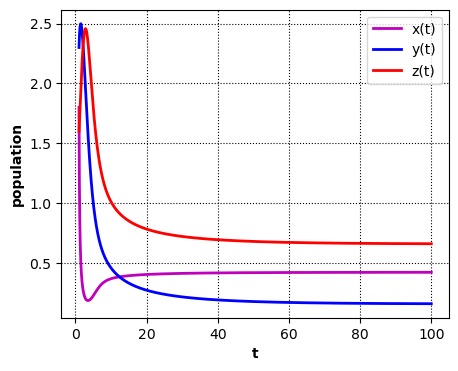Dynamic Analysis of the Modified Leslie Gower Model with Harvesting of Prey and Holling Type II Functional Response
Main Article Content
Abstract
This article studies the Modified Leslie-Gower model with constant business harvesting on the prey and functional response of Holling Type II. This approach is more realistic in several phenomena, one of which is in the phenomenon of rice fields, jali snakes, and owls. The research method begins by determining the assumptions for constructing models, stability analysis, and numerical simulations. Analysis of the equilibrium points was carried out to determine the condition of its stability locally using the Jacobian approach and the Routh-Hurwitz criteria by obtaining five existing points. Analysis of stability using the Jacobian matrix shows that the equilibrium point is an asymptotic node in certain conditions. Numerical simulations are carried out to determine the suitability of the results of the analysis using the software Maple and Python. Numerical simulation results show differences in the value of environmental carrying capacity affect changes in system solutions. Thus, the change in the value of carrying capacity does not always produce the same stability because the stability of the system depends on the sensitivity of the parameter to the overall dynamic structure. This finding provides a foundation for the management of biological resources, especially in controlling harvesting so that the population remains balanced.
Article Details

This work is licensed under a Creative Commons Attribution-NonCommercial-NoDerivatives 4.0 International License.
References
Darmayani S, Hidana R, Latumahina FS, Nendissa SJ, Situmorang MV, Juniatmoko R, et al. Ekologi, Lingkungan Hidup dan Pembangunan. Widina; 2021.
Bailey DF, Boyce WE, DiPrima RC, Braun M. Elementary Differential Equations and Boundary Value Problems. vol. 84. 11th ed. Wiley; 1977.
Kasim R, Panigoro HS, Rahmi E, Nuha AR, Arsal A. The Occurrence of a Neimark-Sacker Bifurcation on a Discrete-Time Predator-Prey Model Involving Fear Effect and Linear Harvesting. Indonesian Journal of Computational and Applied Mathematics. 2025 Feb;1(1):29-38.
Abubakar AS, Panigoro HS, Djakaria I, Nuha AR, Hasan IK, Asriadi A. A Mathematical Model of the Mud Crab (Scylla Sp.) Involving Cannibalism and Refuge. Indonesian Journal of Computational and Applied Mathematics. 2025 Feb;1(1):39-51.
Panigoro HS, Rahmi E, Bonyah E, Akgül A, Jose SA. Dynamical Behaviors of a Fractional-Order Predator–Prey Model: Insights into Multiple Predators Competing for a Single Prey. Fractals. 2025 Feb;2540077:1-18.
Huo HF, Wang X, Castillo-Chavez C. Dynamics of a stage-structured leslie-gower predator-prey model. Mathematical Problems in Engineering. 2011;2011:22.
Panja P, Mondal SK, Chattopadhyay J. Dynamical Effects of Anti-predator Behaviour of Adult Prey in a Predator-Prey Model with Ratio-dependent Functional Response. Asian Journal of Mathematics and Physics. 2017;1(1):19-32.
Holling CS. The Functional Response of Predators to Prey Density and its Role in Mimicry and Population Regulation. Memoirs of the Entomological Society of Canada. 1965 May;97(S45):5-60.
Mortuja MG, Chaube MK, Kumar S. Dynamic analysis of a modified Leslie-Gower model with Michaelis-Menten prey harvesting and additive allee effect on predator population. Physica Scripta. 2024;99(11):102-18.
Ditmars RL. Snakes of the world. The Macmillan Company; 2014.
Ardigurnita F, Frasiska N, Firmansyah E. Burung Hantu (Tyto alba) Sebagai Pengendali Tikus Sawah (Rattus argentiventer) di Desa Parakannyasag Kota Tasikmalaya. Jurnal Abdimas Kartika Wijayakusuma. 2020;1(1):12-21.
Listyana L, Hartono, Krisnawan KP. Analisis Bifurkasi pada Model Matematis Predator Prey Dengan Dua Predator. Jurnal Kajian dan Terapan Matematika. 2016;5(6):1-12.
Suryanto A, Darti I, Trisilowati. Dynamic Behavior of a Harvested Logistic Model Incorporating Feedback Control. Communications in Mathematical Biology and Neuroscience. 2024;2024(4):1-11.
Aziz-Alaoui MA, Daher Okiye M. Boundedness and Global Stability for a Predator-Prey Model with Modified Leslie-Gower and Holling-Type II Schemes. Applied Mathematics Letters. 2003;16(7):1069-75.
Liu X, Chen L. Complex dynamics of Holling type II Lotka-Volterra predator-prey system with impulsive perturbations on the predator. Chaos, Solitons and Fractals. 2003 Mar;16(2):311-20.
Anton H, Rorres C, Kaul A. Elementary Linear Algebra. Wiley; 2019.
Pada Das K. A study of harvesting in a predator–prey model with disease in both populations. Mathematical Methods in the Applied Sciences. 2016;39(11):2853-70.
Tang B, Xiao Y. Bifurcation analysis of a predator-prey model with anti-predator behaviour. Chaos, Solitons and Fractals. 2015 Jan;70(1):58-68.
Savitri D, Panigoro HS. Bifurkasi Hopf pada model prey-predator-super predator dengan fungsi respon yang berbeda. Jambura Journal of Biomathematics. 2020 Dec;1(2):65-70.
Zhou X, Cui J, Shi X, Song X. A modified Leslie-Gower predator-prey model with prey infection. Journal of Applied Mathematics and Computing. 2010;33(1-2):471-87.

